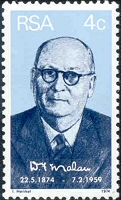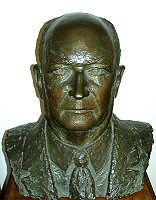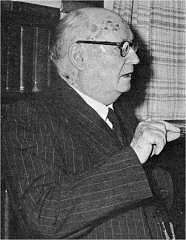
Deus Arx mea
Malan coat of arms

commemorative stamp 1974
(after a drawing by I. Henkel)

See also Artist's portraits
of famous Stellenbosch Authors

D.F. Malan and wife at their home, Môrewag, Stellenbosch
 Deus Arx mea Malan coat of arms |  commemorative stamp 1974 (after a drawing by I. Henkel) |  See also Artist's portraits of famous Stellenbosch Authors |  D.F. Malan and wife at their home, Môrewag, Stellenbosch |

Photo from 1956
Daniël (Danie) Francois Malan was born on 22 May 1874 on the farm Allesverloren near Riebeeck
Kasteel. He obtained a BA in Arts and Science at the Victoria College (later
Stellenbosch University),
a MA in Philosophy and - after more studies at Utrecht
University in Holland - a PhD in Theology. He was an active member of the
university Debatsvereniging, the Studenten Zending Vereniging and an editorial member of the Stellenbosch Student's Quarterly and Annual.
He served as a minister of the Dutch Reformed Church in Montagu (until 1915)
and travelled as a preacher for several years throughout South Africa, the
Belgian Congo and Southern Rhodesia.
Malan joined the National Party in 1915, became the first editor of Die Burger and was elected to Parliament in 1918. Under the leadership of Premier
Hertzog, Malan was given the post of Minister of the Interior, Education and
Public Health in 1924, where he remained until 1933, when he left the
government, opposing the merger between Hertzog's National Party and the rival
South African Party of Jan Smuts. Like most Afrikaaners he did not want South Africa to participate in World
War II. Malan defeated Jan Smuts in the election of 1948.
Danie Malan was an ardent fighter for the acceptance of the Afrikaans language and helped found the Afrikaanse Taalvereniging (1906) together with De Waal, D F Malherbe, D F du Toit Malherbe and A I Perold. On 13 August 1908 he delivered a speech in Stellenbosch (albeit in Dutch): Het is ons erns. (Hofmeyer 1905: Is 't ons erns ?) He was also a founder member of the SA Akademie vir Wetenskap en Kuns (1909). As Minister of the Interior he insured that Afrikaans obtained full parliamentary recognition (in 1925). Thanks to his efforts and that of other members of the Waaksaamheidskommissie, Stellenbosch University survived as an Afrikaans medium university, when there were tendencies to close its doors in favour of a Central University in Cape Town.
D F Malan lived at Brandwag, Sea Point and from about 1945/46, with his second
wife, Maria Louw, in his
house, Môrewag, in Stellenbosch. (While writing his book his favourite cat,
Naamloos, kept him company.)
He died on 7 February 1959 at Môrewag. A collection of his writings and
documents is found at the D F Malan Gedenksentrum in Stellenbosch.
I need a photo and more information, please contact me!
![]()